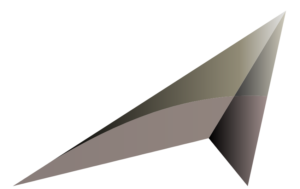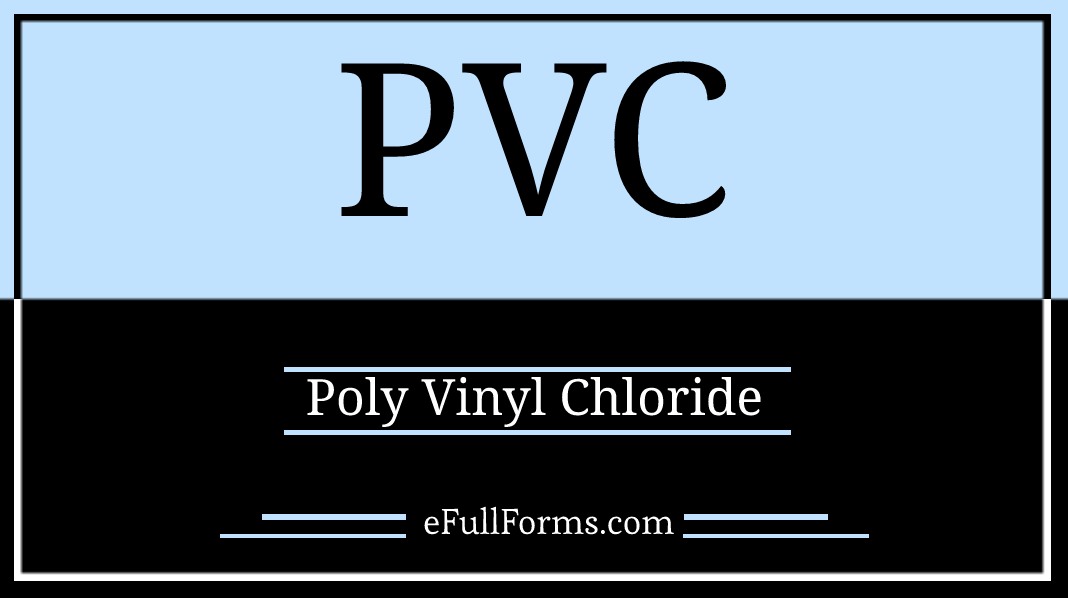PVC Full Form: What Does PVC Stand For?
Do you want to know what is full form of PVC is? Then, here you will come to know what Does PVC stand for? Also all possible Full Form of PVC.
Table of Contents
PVC Full Form
The term PVC has many full forms, but out of which most relevant full form is-
PVC Full Form is – Poly Vinyl Chloride
Polyvinyl chloride (PVC, PVC) is a synthetic polymer, the monomer unit of which is an ethylene chloride molecule (vinyl chloride, vinyl chloride, vinyl chloride, chloroethylene, chloroethene, ethylene chloride), which has the chemical formula CH2 = CCl. Accordingly, as a vinyl chloride chain polymer, polyvinyl chloride has the formula (-CH2-CCl-) n, where n is the degree of polymerization.
The polymer is synthesized by the mechanism of radical-chain polymerization, which occurs in a block or in suspension. According to the synthesis method, polyvinyl chloride is divided into emulsion PVC-E and suspension PVC-S. Also, the types of polyvinyl chloride materials (PVC compositions) are conventionally divided into two groups:
- non-plasticized or rigid material (designations in different sources – vinyl plastic, PVC-R, PVC-U, RPVC);
- plasticized, or soft PVC, or plastic compound (designated PVC-F, PVC-P, FPVC).
Polyvinyl chloride is inherently an amorphous polar polymer.
What are the properties of PVC?
The main properties of polyvinyl chloride are considered incombustibility, oxidation resistance, relatively simple combination with other materials, and low heat resistance. The density of pure PVC is 1350-1430 kg / m3. The bulk density of the material is 400-700 kg / m3. Let’s consider the characteristics of the polymer in more detail.
Physical and mechanical properties:
- White powdery material;
- Odorless and tasteless;
- Has good dielectric characteristics;
- High water resistance, resistance to acids, bases, oils, alcohols;
- Low resistance to the action of ethers, acetones, chlorinated hydrocarbons, aromatics;
- Mixes well with plasticizers, modifiers, and other chemicals.
Chemical characteristics:
- Does not support combustion;
- Degrades in case of strong heating;
- Self-ignition occurs with sharp heating up to 1100 degrees C;
- Glass transition temperature – 70-80 degrees C.
What Does PVC Stand For?
PVC stands for – Poly Vinyl Chloride
PVC is resistant to moisture, basic acids, alkalis, salt solutions, and industrial gases such as chlorine and nitrogen dioxide. The material is also resistant to gasoline, kerosene, fats, and alcohols—Soluble in acetone and benzene to a limited extent. It dissolves in dichloroethane and nitrobenzene. Polyvinyl chloride is harmless to health and the environment. In its pure form, polyvinyl chloride is rather difficult to process; therefore, for the production of PVC products, it is mixed with various plasticizers, the proportion of which, depending on the required properties of the final product, can reach 30% of the total weight of the product. As a result, the stiffness parameters of the final product can vary within wide limits. …
PVC is one of the most widely used polymers, with over Three Thousand different materials and products derived from it:
- Advertising: signboards, advertising and exhibition stands, etc.;
- Construction: models, partitions, siding, interior decoration, ventilation pipes, etc.;
- Industry: cabinets and control panels, corrosive environment design, etc.;
- Digital printing;
- Food industry: packages, trays, containers;
- Heavy engineering;
- Shipbuilding;
- Medicine.
Polyvinyl chloride (PVC) [-CH 2 -CHCl-] n is a high molecular weight chlorine-containing polymer, the elementary units in the macromolecule of which are mainly connected in a “head-to-tail” manner.
Polyvinyl chloride is a thermoplastic polymer with a glass transition temperature of 70–80 ° C and a viscous flow temperature of 150–200 ° C, depending on the molecular weight. The degree of polymerization of industrial grade PVC ranges from 400 to 1500.
The properties and purpose of polyvinyl chloride are primarily determined by the method of its production. PVC properties can also be changed by chemical modification. The availability of raw materials (vinyl chloride), relatively simple production methods, and valuable technical properties have led to the rapid growth and large scale of its production.
Plastics based on polyvinyl chloride are widely used in the electrical and chemical industries, in construction, and in other areas of technology and everyday life.
What is the History of PVC?
Polyvinyl chloride (PVC) is one of the oldest artificial materials. It all started with the fact that in 1835 the German chemist Justus von Liebig synthesized vinyl chloride – a compound that in a hundred years was to play a huge role in industry and everyday life. In 1872, the German Eugene Baumann first obtained a polymer of this substance – polyvinyl chloride (PVC), and in 1912 Fritz Klatte patented an industrial method for the production of PVC – he intended to use hardly flammable polyvinyl chloride instead of highly flammable celluloid. Unfortunately, the outbreak of the First World War prevented Fritz Klatte from undertaking a detailed study of the properties of PVC and the possibilities of its use, and production was suspended. Nevertheless, Klatte is rightfully considered the founder of PVC industrial production.
What are the Properties of PVC?
Weather resistance. PVC is resistant to aggressive environmental factors, and therefore is the most common polymer for the manufacture of roofing
Versatility: PVC can be flexible or rigid
Fireproof: PVC is one of the hard-flammable materials due to the presence of chlorine in its molecule
Durability: PVC materials can last up to 100 years or more
Hygiene: PVC is the most widespread polymer for manufacturing medical products, in particular containers for storing blood components.
Barrier properties: PVC has a very low permeability to liquids, vapors, and gases
Recyclable: PVC is more recyclable than many other polymers
Safety: PVC has so often been subjected to unwarranted attacks, which had to be refuted through rigorous scientific research. Today, it is one of the most studied materials in the world.
Profitability: PVC is the cheapest of large-scale polymers, providing the best price-quality ratio for many products.
What is Full Forms of PVC
Now, here is the complete Full-Form list of the term PVC.
| Sr. No. | Term | Category | PVC Full Form |
|---|---|---|---|
| 1 | PVC | Polimer | Poly Vinyl Chloride |
| 2 | PVC | Education | Pacific View Charter |
| 3 | PVC | Medical | Packed Cell Volume |
| 5 | PVC | Education | Palo Verde College |
| 6 | PVC | Education | Palos Verde Continuation |
| 9 | PVC | Vacuum Cleaner | Panasonic Vacuum Cleaner |
| 10 | PVC | Video Cameras | Panasonic Video Cameras |
| 11 | PVC | Automotive | Panel Van Conversion |
| 12 | PVC | Community | Paradise Valley Community |
| 13 | PVC | Award | Param Veer Chakra |
| 14 | PVC | Coding | Parameter Value Coverage |
| 15 | PVC | Schools | ParkView Cowboys |
| 16 | PVC | Information Technology | Partial Value Code |
| 17 | PVC | Educational | Partial Volume Concentration |
| 18 | PVC | Medical | Partial Volume Correction |
| 19 | PVC | Voluntary Organization | Passion, Vision, and Committment |
| 20 | PVC | Media Center | Passive Volume Control |
| 21 | PVC | Music | Pedal Volume Control |
| 22 | PVC | Automotive | Pedestrian Vehicle Collision |
| 23 | PVC | Automotive | Pedestrian Vehicle Crash |
| 24 | PVC | Legislation | Penalty Versus Corruption |
| 25 | PVC | Automotive | Pennsylvania Vehicle Code |
| 26 | PVC | Uncategorized | Pepperdine Volunteer Center |
| 27 | PVC | Navigation | Percent Volume Contour |
| 28 | PVC | Medical | Peripheral Venous Catheter |
| 29 | PVC | Technology | Permanent Virtual Channel |
| 30 | PVC | Information Technology | Permanent Virtual Circuit |
| 31 | PVC | Technology | Permanent Virtual Circuits |
| 34 | PVC | Clothing | Permanent Virtual Connection |
| 35 | PVC | Politics | Permanent Voter Card |
| 36 | PVC | Marketing | Perpetual Virtue Contribution |
| 37 | PVC | Medical | Persistent Vaginal Cornification |
| 38 | PVC | Uncategorized | Persistent Volume Claim |
| 39 | PVC | Pharmaceutical | Personalised Ventilation Center |
| 40 | PVC | Automotive | Peugeot Vietnam Club |
| 41 | PVC | Power | Photovoltaic Cell |
| 42 | PVC | Pharmaceutical | Pigment Volume Concentration |
| 43 | PVC | Funny | Pipe Very Crowded |
| 44 | PVC | Funny | Plastic and Very Cheap |
| 45 | PVC | Uncategorized | Plastic Very Compact |
| 46 | PVC | Plastics | Plasticized Vitreous Compound |
| 47 | PVC | Engineering | Ploy Vinyl Chloride |
| 48 | PVC | Environmental Health | Polyvinyl Chloride Powder |
| 49 | PVC | Educational | Porous Vent Coaxative |
| 50 | PVC | Technology | Position and Velocity Computer |
| 51 | PVC | Information Technology | Positive Verified Connect |
| 52 | PVC | Funny | Positive Vibes Collective |
| 53 | PVC | Hobby | Postal Verification Card |
| 54 | PVC | Medical | Premature Ventricular Complex |
| 55 | PVC | Pharmaceutical | Premature Ventricular Contractions |
| 56 | PVC | Oil | Pressure Control Valve |
| 57 | PVC | Educational | Pressure Velocity Correction |
| 58 | PVC | Educational | Pre-Vacuole Compartment |
| 59 | PVC | Information Technology | Previous Virtual Cell |
| 60 | PVC | Marketing | Price Validation Code |
| 61 | PVC | Information Technology | Primary Version Control |
| 62 | PVC | Medical | Primary Visual Cortex |
| 63 | PVC | Cultivation | Prime Venezuelan Calf |
| 64 | PVC | Educational | Primitives Volumes and Collections |
| 65 | PVC | Clubs | Princeton Varsity Club |
| 66 | PVC | Juridical | Priority Versus Claim |
| 67 | PVC | Automotive | Private Vehicle Conveyance |
| 68 | PVC | Technology | Private Virtual Circuit |
| 69 | PVC | Technology | Private Virtual Connection |
| 70 | PVC | Education | Pro Vice Chancellor |
| 71 | PVC | Local – Countries | Pro Video Coalition |
| 72 | PVC | Automotive | Propane Vehicle Council |
| 73 | PVC | Clubs | Proud Violators Club |
| 74 | PVC | Politics | Pro-Video Coalition |
| 75 | PVC | Airport Codes | Provincetown Municipal Airport, USA |
| 76 | PVC | Educational | Psychedelic Variable Consciousness |
| 77 | PVC | Media Center | Public Voice Channel |
| 78 | PVC | Cardiology | Pulmonary Valve Closure |
| 79 | PVC | Pharmaceutical | Pulmonary Venous Confluence |
| 80 | PVC | Medical | Pulmonary Venous Congestion |
| 81 | PVC | Housing & Amenities | Purple Velvet Curtains |
FAQ on PVC
What is Full Form of PVC Plastic?
Polyvinyl Chloride Plastic
What is PVC Gas Full Form?
Polyvinyl Chloride
Final Words:
I hope you get what you want to know about PVC. If you want to know the full forms of other term, then please ask by comments or email. Your valuable comments are always welcome.



